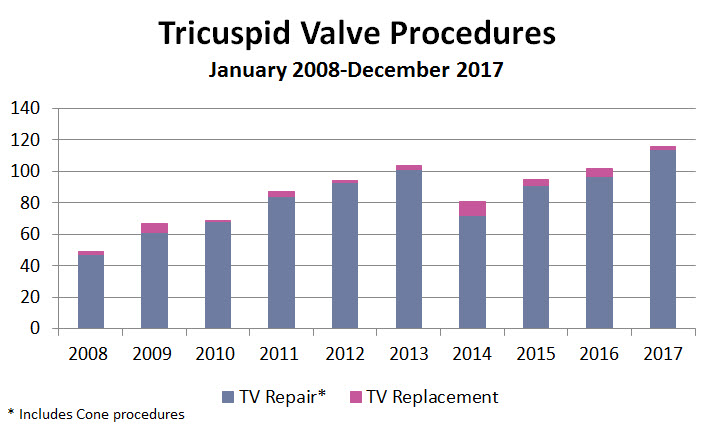Tricuspid Valve | Overview
Patients with tricuspid valve disease are often referred to Boston Children’s. In many cases, these patients were referred for other associated cardiac surgical conditions, including congenital tricuspid stenosis, tricuspid regurgitation and Ebstein's anomaly. Often, their tricuspid disease is repaired at the same time and through the same operation as the associated disease.
Tricuspid valve surgical experience and results
Between 2005 and 2011, we performed more than 400 operations that included a tricuspid valve repair, including more than 70 Cone operations in patients with Ebstein's anomaly since 2006.
Our techniques have continued to improve and, each year, the number of patients undergoing this operation has risen. We have seen excellent results in this group of patients. There have been very few re-operations for recurrent tricuspid valve regurgitation and nearly 100% survival.

Advanced imaging of the tricuspid valve and associated structures
Our advanced imaging techniques, including two- and three-dimensional cardiac echocardiography and cardiac magnetic resonance imaging (MRI), are extremely valuable for evaluating patients with tricuspid valve disease. These techniques are particularly important in patients with Ebstein's anomaly, as they provide an excellent “roadmap” that helps in preparing for surgical repair.
Tricuspid valve clinical studies & trials
We are currently evaluating results of recent studies on patients with Ebstein's anomaly undergoing the Cone procedure. The results of this analysis may allow us to predict the optimal timing for surgery and determine when other procedures, such as a bi-directional Glenn procedure, may be beneficial.
At Boston Children's, we are helping to develop a clinical trial for a device that may be beneficial in reducing the amount of regurgitation in patients with HLHS who have had the Norwood and many who have had a bi-directional Glenn (BDG) or Fontan procedure.
Other unique situations associated with the tricuspid valve
Children born with hypoplastic left heart syndrome (HLHS) often develop significant tricuspid valve regurgitation, in which the blood flows backwards. This may contribute to increased sickness in these fragile patients. Many of these patients will benefit if their tricuspid valve can be repaired in a way that minimizes the associated regurgitation.
Conditions associated with tricuspid valve disease
Ebstein’s anomaly
Primary dysplastic tricuspid valve disease
Tricuspid regurgitation associated with
- Tetralogy of Fallot (TOF) and pulmonary regurgitation
Pulmonary atresia/intact ventricular septum (PA/IVS)
Endocarditis involving tricuspid valve
